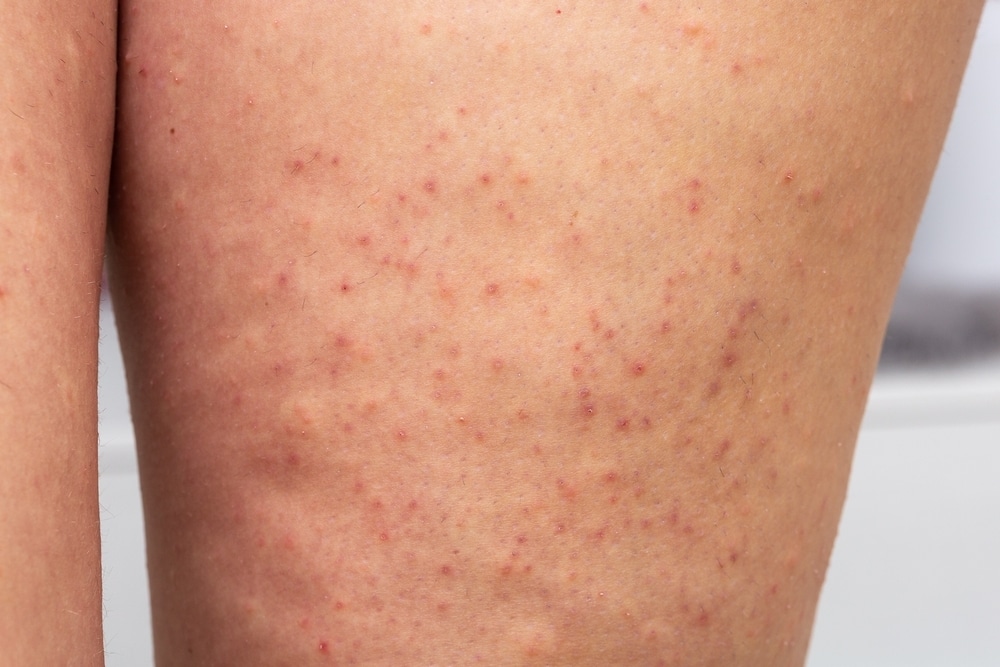Keratosis pilaris, playfully referred to as "strawberry skin," is a common condition that affects both men and women as well as both adults and children. Although it may be irritating and cosmetically displeasing, the good news is that it's a benign skin condition and there are ways to keep it at bay. Read on to learn how to get rid of keratosis pilaris, and how to keep it away for good.
What Is Keratosis Pilaris?

Keratosis pilaris is a skin condition caused by an overproduction of a natural protein called keratin. It often appears as small pink-to-red rough bumps on your skin—similar to the outside of a strawberry or the skin of a plucked chicken.
Though keratosis pilaris is a benign condition, some may find it unsightly or bothersome. Because of the red bumps, keratosis pilaris is often confused with acne, but they're not the same. There are a few ways you can differentiate keratosis pilaris from other common skin conditions. For starters, keratosis pilaris is unique in that these small bumps often have a roughness like sandpaper and often appear on already dry skin. They typically appear on your upper arms, thighs, and buttocks. And, according to the American Academy of Dermatology (AAD), many patients report that the bumps go away in the summer and return in the winter. If you suspect the irritating red bumps on your skin are keratosis pilaris, schedule a visit with a board-certified Dermatologist to get a definitive diagnosis.
What Causes Keratosis Pilaris?
When your body builds up too much keratin, that extra protein eventually dies off and the dead skin cells can clog your pores. These clogged pores become inflamed and cause a hard, red scale to pop up. Accompanied by the sandpaper feel, it's not pleasant, though it is common, especially in children and teens. There are many causes of keratosis pilaris, and once you pin down the cause, you can start working on how to get rid of strawberry skin.
So, what causes these bumps to appear? The AAD suggests that family history may play a role in developing keratosis pilaris, among other things, including:
- A history of asthma
- A history of atopic dermatitis (eczema)
- Obesity
- Genetic skin conditions that may cause very dry skin (i.e., ichthyosis vulgaris)
- Hormonal changes
- Allergy to hay fever
Even though keratosis pilaris is not contagious nor life-threatening, it can knock your self-confidence. Many with keratosis pilaris may shy away from certain clothing that exposes the rough and bumpy rash. These are some of the reasons why early treatment of keratosis pilaris is essential.
How to Get Rid of Keratosis Pilaris
As far as at-home care goes, gentle exfoliation is key to treating keratosis pilaris. Look for products that contain exfoliating ingredients like Glycolic Acid, Lactic Acid, and Salicylic Acid. If you're living with keratosis pilaris, your Dermatologist can help you identify products that are safe for your skin type and color. It's important to be cautious with exfoliation because over-exfoliation can cause more harm than good, and some products may be too harsh and may trigger rashes, irritation, and even aggravate your keratosis pilaris. Look for a chemical exfoliant that also contains hydrating skin ingredients such as ceramides, Niacinamide, Glycerin, Hyaluronic Acid, and Vitamin E as this may minimize skin irritation. The frequency of using a topical chemical exfoliant is dependent on the ingredients and the vehicle (i.e., cream, lotion, cleanser). Start slow, only exfoliating a few times a week, and then work up to more often if your skin can handle it.
Soothe freshly exfoliated skin with an ultra-hydrating moisturizer like the EltaMD Skin Recovery Light Moisturizer. This moisturizer is formulated with Squalane, Coconut Fruit Extract, and Sodium Hyaluronate to nurture dehydrated, flaky skin and prevent further dryness.
Keratosis pilaris may be a nuisance, but it can be managed with gentle, exfoliating, and hydrating products. All it takes is a little TLC and you'll be rewarded with smooth, supple skin.